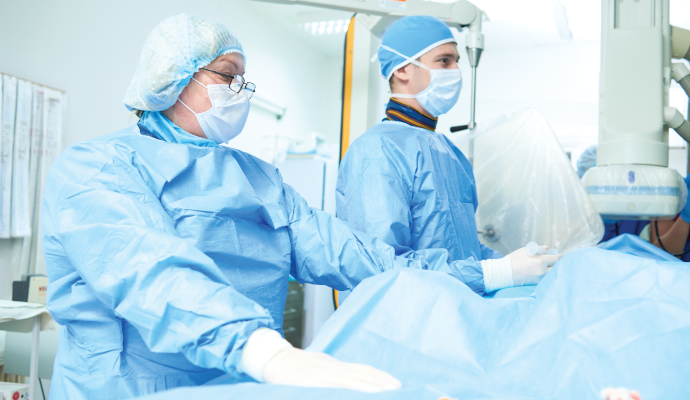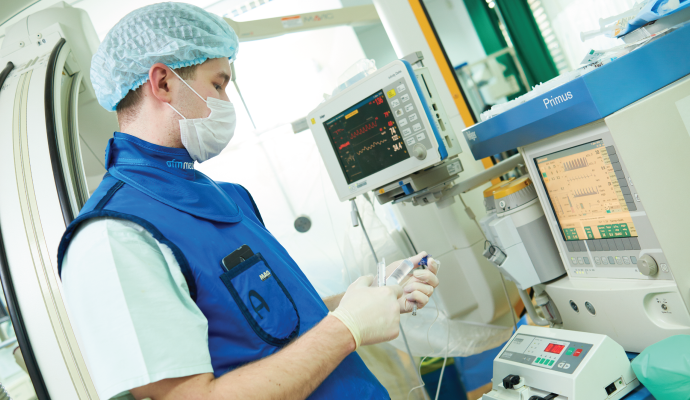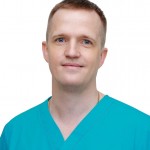X-ray surgery
1st floor
The X–ray surgery is a unique department dealing primarily with interventional cardiology in pediatric patients with congenital and acquired heart defects, as well as cardiac arrhythmias. More than 700 patients are operated on in the department per year, and 1,000 diagnostic and X-ray examinations are performed.
The main task of the department is to conduct minimally invasive endovascular surgical interventions for the treatment of congenital heart defects, perform diagnostic probes for structural pathology of the heart and surgical treatment of cardiac arrhythmias (tachyarrhythmias and bradyarrhythmias).
To perform a significant range of high-tech X-ray endovascular interventions, the department is equipped with the most modern equipment from the world’s best manufacturers.
The main task of the department is to conduct minimally invasive endovascular surgical interventions for the treatment of congenital heart defects, perform diagnostic probes for structural pathology of the heart and surgical treatment of cardiac arrhythmias (tachyarrhythmias and bradyarrhythmias).
To perform a significant range of high-tech X-ray endovascular interventions, the department is equipped with the most modern equipment from the world’s best manufacturers.



Department staff
The specialists of the X-ray surgery department have extensive experience in providing specialized care to children with congenital heart defects, have held master classes and internships in Europe and the USA. The medical team has extensive experience in providing specialized care in countries such as Azerbaijan, Russia and Ukraine. The specialists of the department represent the Center for Pediatric Surgery at international conferences and master classes. Every year we train specialists from different countries.

CHERNOGLAZ
Pavel Feliksovich
X-ray and endovascular surgeon
(Head of the department)
Pavel Feliksovich
X-ray and endovascular surgeon
(Head of the department)

SHEVCHENKO
Nikolay Sergeevich
X-ray and endovascular surgeon
Nikolay Sergeevich
X-ray and endovascular surgeon

ILBUT
Tatyana Andreevna
X-ray and endovascular surgeon
Tatyana Andreevna
X-ray and endovascular surgeon

ZHUK
Alexey Yurievich
X-ray and endovascular surgeon
Alexey Yurievich
X-ray and endovascular surgeon

KADOCHKIN
Vitaly Olegovich
cardiac surgeon

ZHIDKO
Vitaly Alexandrovich
anesthesiologist
and intensive care specialist of the highest category
Vitaly Alexandrovich
anesthesiologist
and intensive care specialist of the highest category

GUSAKOVSKY
Dmitry Vladimirovich
anesthesiologist and intensive care specialist
The range of services of the department
Thanks to the long-term and successful work of the team, the clinic has accumulated a unique experience in the use of X-ray endovascular surgery methods in the treatment of patients with congenital malformations
The main endovascular interventions performed in the department are:
emergency endovascular interventions for newborns
closure of atrial septal defects, ventricular septal defects, open arterial duct
stenting of constrictions of large main vessels and heart and other localizations
transcatheter implantation of prosthetic heart valves
endovascular interventions in vascular malformations
implantation and replacement of pacemakers, cardioverter defibrillators, cardioresynchronizing devices
implantation of event monitors (long-term ECG monitoring)
performance electrophysiological research, radio frequency and cryoablation for tachyarrhythmias
diagnostic catheterization of the heart and blood vessels in various pathologies
